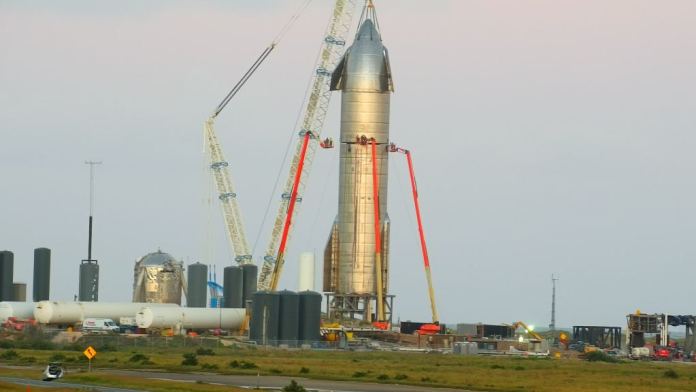It’s beginning to look like SpaceX will attempt to make the 15 km (9.3 mi) hop test before Christmas! After two successful 150 m (~500 ft) hops with the SN5 and SN6 prototypes, engineers at SpaceX’s Boca Chica launch facility in South Texas rolled out the SN8 – the first Starship prototype to have three Raptor engines. But before the SN8 can conduct a high-altitude test flight, the engineers needed to run a static fire test.
This test is crucial to ensuring that the Starship‘s interior plumbing can handle its cryogenic propellants, and is the last milestone before the Starship can conduct a high-altitude flight. On the evening of Tuesday, October 20th, that’s exactly what they did! At 3:13 AM local time (01:13 AM PDT; 04:13 AM EDT), the SN8 fired up its three Raptor engines and kept firing them for several seconds straight.
Although SpaceX has not yet released a statement about the test, footage captured near the launch facility by NASA Spaceflight’s Mary McConnaughey (aka. @BocaChicaGal) would suggest that it was a success. The video of the event (posted below) shows the engine being ignited at 2h27m12s after several minutes of venting and remaining lit for several seconds.
With this milestone achieved, the company appears ready to conduct the historic 15 km (9.3 mi) hop test. At this point, that seems likely to happen before the end of October or in early November. While the SN8 was receiving its three Raptor engines and preparing to test fire them, another team was busy assembling the nose cone in another part of the facility.
Not since the Starhopper test vehicle was in active service has a Starship prototype come with a nose cone. However, this segment was removed shortly after the Starhopper blew over in high winds in January of 2019. What remained, the single-engine lower section, went on to conduct a tethered hop test, followed by a first free-flight hop test to 20 meters (~65 ft).
In August of 2019, these tests culminated in a 150 meter (~500 ft) hop test, a feat that would not be accomplished again until a year later with the SN5 and SN7 prototype. Since then, the development of the SN8 has proceeded apace, which began with the core undergoing a series of proof tests (from Oct. 6th to Oct. 8th) to validate its stainless steel propellant tanks in preparation for its static fire test.
What followed was the addition of the large maneuvering flaps to the core section and nose cone. The nose cone was then attached by crane to the SN8 fuselage on Thursday (Oct. 22nd), an event that was witnessed by multiple observers who took pictures and footage. Above is a time-lapse video of the stacking operation recorded by @LabPadre, which was made using their 24-hour live-coverage of the Boca Chica launch facility.
With the nose cone and flaps installed, the vehicle now looks like the finalized Starship design for the first time. With its three engines, nose cone, and maneuvering flaps integrated, the SN8 is about ready to attempt its 15 km (9.3 mi) hop test, which will include a “belly-flop” maneuver that will test its ability to glide back to its landing site using its maneuvering surfaces alone.
According to past statements by Musk, SpaceX hopes to conduct a suborbital hop test to an altitude of 200 km (~125 mi) sometime next year. For this final test, the Starship will be equipped with six Raptor engines – three optimized sea-level thrust and three optimized for the vacuum of space. The company is also busy working on the Super Heavy element of the launch system, which will have no less than 28 Raptor engines.
Further Reading: ArsTechnica
– Advertisement –
